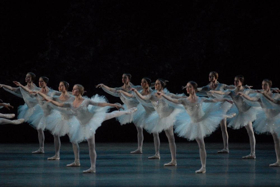BWW Dance Review: La Bayadère

As much as we all love dance-since it is the art that means the most to us, not to mention the one we have studied at length and at cost-there is always a time when we have to stand back and ask ourselves as we go out one evening, "Do I really want to see this?"
That's very much the way I thought about American Ballet Theatre's La Bayadère on the evening of May 31, 2018, at the Metropolitn Opera Hourse in Lincoln Center. I've seen the ballet on many previous occasions and never warmed up to it. I'm not sure if it's the hokey story or the truly atrocious music by Ludwig Minkus, here specially arranged by John Lanchberry. Is it me or am I totally crazy: Doesn't Lanchberry quote the Grieg Piano Concerto a half dozen times? If not, it sure does sound like it!!!!
If we think the story takes the cake, its birth is even stranger.
Let's take a closer look. Bayadère is the French word for an Indian temple dancer, and the leading character, Nikiya, is in the profession. The ballet is set in ancient India, an exotic setting for audiences of the 19th century. There was also a heavy influence of Verdi's Aida, since Petipa had recently choreographed a production of the opera. If you look closely at the characters in the opera, they bear a resemblance to the ballet's leading dancers.
Now to the good part.
Petipa took about six months preparing the ballet for Ekaterina Vazem, a prima ballerina in St. Petersburg, who wasn't very happy with her part and never stopped complaining. To make matters worse, the theater raised its ticket prices, which worried Petipa since he believed that people would stay away. The only thing that pleased Petipa was his vision scene, the Kingdom of the Shades, almost totally devoid of any story and just an extended dance sequence utilizing a 32 member women corps. A success at the time, Petipa revived it a few times after that, the last being in December 1900 for the dual benefit performance of Pavel Gerdt, the Imperial Theatre's premier danseur, and prima ballerina Mathilde Kschessinskaya. In this version, he reset the Kingdom of Shades from 32 to 48 dancers, then or now a huge body of female dancers on stage.
Agrippina Vaganova later choreographed her version in 1932, while the Kirov offered another one in 1941, this time choreographed by Vladimir Ponomarev and Vakhtang Chabukiani. It would be the definitive staging of La Bayadère, all other versions following its structure and choreography in one way or another. In 1974 Makarova mounted The Kingdom of the Shades for American Ballet Theatre, later staging her own version in 1980, which is the one that has been in the repertoire since then.
That's quite a history!!!!
All of which brings us to the La Bayadère that I saw. It was beautifully danced; the scenery and the lighting were fine, the orchestra played well. So what was wrong?
It was long--way too long. That's carping, and I always apologize, but there is a reason why the Kingdom of Shades is totally admired by audiences the world over. It is a ballet by itself, no reason needed for its existence. While it is part of the ballet's story, it stands apart, pristine in its beauty and form.
When you first see the dancers coming down the ramp one by one you feel uplift in spirits. As their numbers swell the stage-in this version we are back to 24 dancers-and they unify, their arms outstretched, it strikes you at once that this is not just dance, but it is one person's life and legacy for us to see. As much as we may stray, we always come back to Marius Petipa, for without his vision, his ability to look into the heart of dance and insert movement to clarify and articulate the music, whether in purely dramatic terms, pure steps or combinations, ballet would have never moved forward. When the curtain falls on Kingdom of the Shades I always breathe just a bit deeper. You are returned to your own realm, but it was a great journey.
I wish we could take more such journeys in the dance world.
Isabella Boylston as Nikiya has been improving as a dancer over the past few years. When I first watched her, I found a lack of coordination in her upper and lower body. Like many ballet dancers, her feet did everything, while she seemed to be flailing from the waist up. Here everything was in sync, and she gave a deep and interesting portrait of her character, at least whatever there is to unearth in Nikiya. Jeffrey Cirio was a compelling Solor, his soars are quite magnificent, and Misty Copeland was a funny Gamzatti, even if this was totally unintentional. When she isn't gesturing, she does do a number of multiple pirouettes, but that's about it.
American Ballet Theatre's corps is one of the finest in the world. I attribute this to...? Irina Kolpakova? She was in the audience the night I saw the performance, so perhaps she was there to impart more knowledge to the dancers?
Are there more Bayadères in my future? Only time will tell.
Photo by MIRA.
Reader Reviews

Videos

